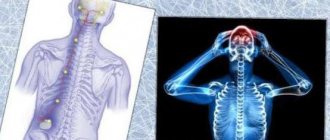Not a sign of illness, but a temporary glitch
Sometimes the problem is not so bad if it is not directly related to health. In some situations, numbness in the head is considered normal, since overstrained muscles are to blame.
Short-term numbness or tingling is usually observed after waking up if the person took uncomfortable positions during sleep.
Being in one position for a long time (for example, sitting at a computer), the muscles experience severe tension and become “numb.” Compression or pinching of the nerve may also occur.
A feeling of numbness in the head and goosebumps are considered normal even with sudden movements of the neck. In such a situation, the blood vessels experience an unexpected spasm.
Each of these moments is accompanied by disruptions in the blood circulation of the brain, which sometimes leads not only to numbness, but also to dizziness. The condition, which is considered normal, lasts for 10-15 minutes. It is enough to wait until the discomfort passes.
Temporary disruptions can be caused by exposure to certain medications. Numbness of the head is often accompanied by taking statins. It is enough to stop taking them, and the symptoms will go away on their own.
Causes
The causes of numbness in the ears are physiological and pathological. The first ones go away on their own and do not require medical attention. The latter are very dangerous and require medical advice.
Physiological causes of ear hypoesthesia:
- Poor circulation caused by an uncomfortable posture of a person during rest. Sleeping on a very hard pillow or on your arm leads to pinching of blood vessels and numbness not only of the ear, but also of the cheek and part of the head. After such a rest, the face looks “bruised”, there is a feeling of a swollen ear, and swelling appears.
- Local or systemic hypothermia . The earlobes go numb in the cold when there is no headgear or does not completely cover the hearing organ. To retain heat inside the body, the blood vessels of the skin spasm. Because of these spasms, the ears turn pale and cold. They experience a painful tingling sensation. In a warm room, blood rushes to the skin of the ears. They turn red, “burn”, and swell. But these unpleasant sensations quickly pass.
Pathological conditions that cause numbness in the ears:
- Vascular disorders - hypertension, coronary heart disease;
- Brain diseases - multiple sclerosis, hemorrhagic or ischemic stroke;
- Pathology of the spinal column – osteochondrosis of the neck and intervertebral hernia;
- Endocrinopathies - hypofunction of the thyroid gland;
- Diseases of the structures of the hearing organ - otitis media, mesotympanitis, labyrinthitis, eustachitis;
- Diseases of molars - caries, periodontitis, pulpitis;
- Oncopathology;
- Head injuries - concussion or contusion of the brain, fracture of the base of the skull;
- Diseases of peripheral nerves - neuralgia of the branches of the trigeminal nerve or neuritis of the facial nerve.
Neurological and other diseases
There are many reasons why the head goes numb in one part or another, but very often this is a symptom of one of the neurological diseases:
- Often this condition is accompanied by problems of the cervical spine. The most common disease in this area is osteochondrosis , which leads to pinched nerves, which provokes not only discomfort in tactile sensations, but also stiffness in head movements.
- Vascular diseases of the brain and cerebrovascular disease are another diagnosis in which the described symptom is present.
- Such symptoms are also observed with head and spinal injuries . Injuries to the back or cervical region, as well as the head, are accompanied not only by “goosebumps” on the body, but also by severe pain, paralysis and many other symptoms.
- It cannot be avoided without numbness of the scalp and with neuroinfections .
- multiple sclerosis develops , the essence of which is the replacement of nervous tissue with connective tissue. This results in numbness of the skin on the head, poor sensitivity of the limbs, and incoordination.
- Tumors of the head or spine , growing, begin to put pressure on neighboring areas, expanding their space. Nerves and blood vessels come under pressure (and displacement), and metastases penetrate the tissue. The processes are accompanied not only by numbness, but also by very severe pain.
The most serious diseases for which numbness is a mandatory symptom relate to the field of oncology. The tumor can be localized in the cervical region or in any part of the brain.
Numbness, goosebumps and tingling are manifestations of sensitivity of the scalp, and the longer such sensations last, the more compelling the reasons that provoke them should be.
The most harmless are colds associated with hypothermia.
Heart disease, hypertension, excess weight lead to disruption of normal blood circulation, which causes vasospasm, resulting in numbness. This condition can be regarded as pre-stroke.
It is impossible to diagnose or eliminate all these factors independently (without the participation of doctors). Therefore, traditional treatment is excluded a priori here.
Symptoms
Regular numbness of the ear, accompanied by unpleasant symptoms, is a manifestation of serious illnesses. You should consult a doctor and begin treatment if paresthesia occurs along with ear congestion, cephalalgia, ear pain, noise and whistling, general weakness, nausea, hearing loss, hypertension, and dyspeptic symptoms.
- Diseases of the cerebral vessels are one of the most common causes of numbness in the ears. Dyscirculatory changes in cerebral structures are manifested by characteristic symptoms: persistent numbness of the ears and head, as well as various areas of the skin on the face. Patients complain that they feel dizzy, have pain and pressure in the back of their heads, feel sick, and vomit. Due to severe weakness and lethargy, they faint and lose consciousness. Motor dysfunction gradually increases, paresis and paralysis develop. The pathology occurs more often in older people and occurs in parallel with hypertension, metabolic obesity and angina pectoris.
- a systemic autoimmune pathology that affects the structures of the central nervous system and is associated with the gradual proliferation of connective tissue fibers in the brain. Clinical signs depend on the location of the lesion and often vary. With this pathology, the ear, head, and face go numb. In patients, the optic nerve is affected, which is manifested by a decrease in visual acuity, a veil before the eye, and a narrowing of the visual fields. Then signs of neuralgia of the trigeminal and facial nerves appear. When symptoms of cerebellar damage occur, dizziness, ataxia, loss of balance, nystagmus, and tremor occur. Multiple sclerosis is characterized by paresthesia - burning, itching, skin tightening, numbness, tingling. Patients feel that their ear, hand or finger, cheek, and wings of the nose are numb. Motor, emotional and mental disorders gradually develop.
Multiple sclerosis- The growth of a tumor in the brain tissue compresses its areas, which leads to damage to the structures of the central nervous system with their severe dysfunction. Patients' ears, tongue, nose, and areas of the face go numb, appetite disappears, hearing and vision are impaired. They become very weak and broken, quickly lose weight, experience severe pain in the head and double vision. As the pathology progresses, patients lose orientation in time and space, perceive taste pervertedly, smell odors that are not there, see and hear hallucinations. Personality degradation occurs. The disease has a serious prognosis and often ends in the death of the patient.
- Otitis and mesotympanitis, as well as inflammation of other parts of the auditory analyzer, manifest themselves with gradually increasing symptoms. First, patients experience pain inside the ear that is pulsating, shooting, or drilling. Their body temperature rises, noise and ringing in the ear occurs, and hearing decreases. After perforation of the eardrum, purulent discharge appears. When visiting a doctor, patients complain that the ear is numb and stuffy, there is discomfort and a feeling of fullness inside.
- One of the causes of ear numbness is osteophytes - growths of bone tissue that occur in response to destructive processes in the musculoskeletal system and compress nearby nerves and blood vessels. Patients experience numbness around the ear and in the upper part of the neck. The ear is stuffy and hurts. There is stiffness of movement in the morning, crunching and pain when moving the head, muscle spasms, forced body position, limited mobility up to complete immobility.
facial neuritis
Facial nerve neuritis is inflammation of the branches of the facial nerve innervating the ear, manifested by loss of sensitivity in this area. Neuritis is usually caused by infections and injuries. In patients, ear sensitivity on the affected side decreases and pain occurs. As the disease progresses, one half of the faces become distorted. Patients have difficulty smiling, frowning and squinting their eyes. If the problem is ignored and not treated, facial paralysis, lacrimal dysfunction, and dry eyes may develop.
- In hypothyroidism , numbness and ear congestion are accompanied by general signs of pathology: cephalalgia, fluctuations in blood pressure, weakness, drowsiness, chilliness, puffiness of the face and swelling of the limbs, changes in the timbre of the voice, weight gain, nausea, flatulence, constipation, slowed speech, decreased mental abilities, fragility and loss of hair, menstrual irregularities.
Diseases manifested by numbness of the ear are closely related.
- Arterial hypertension, angiopathy, disturbance of the rheological properties of blood are pathological processes leading to the development of dangerous conditions: ischemic or hemorrhagic stroke. All of them are accompanied by paresthesia of the head, including the ears.
- Tumors compress neurovascular bundles, which leads to disruption of blood supply and innervation of certain parts of the body. About the same thing happens with osteochondrosis: osteophytes compress blood vessels and nerves. Dyscirculatory processes are always accompanied by a sensitivity disorder in the affected area.
- Inflammation of various parts of the hearing organ is manifested by tissue swelling and accumulation of purulent exudate, which put pressure on the nerve endings and capillaries, causing numbness and pain.
In the absence of timely and competent treatment of diseases manifested by numbness of the ear, patients develop severe complications:
numbness and facial deformation due to stroke
Facial deformation - curvature, drooping corners of the mouth and eyes, hyperemia or pallor of one half;
- Discoordination of movements – unsteadiness of gait, limping;
- Psychomotor excitability or retardation, apathetic or aggressive state;
- Incoherent, slurred speech with occasional screaming or monotonous muttering;
- Violation of worldview, lack of response to surrounding stimuli, lack of contact, lack of initiative.
Such conditions are extremely dangerous. They often lead to irreversible consequences and death. Frequent numbness in the ear, accompanied by unpleasant symptoms, is a reason to consult a doctor.
Warning signs requiring immediate treatment:
- Ear congestion lasting more than an hour
- A tingling sensation that does not go away for a few seconds
- Persistent weakness that does not allow a person to live and work fully,
- Spread of numbness from the ear to the surrounding structures of the head,
- Hearing loss
- Persistent nausea with vomiting,
- Sharp pain when touching the ear,
- Urinary and fecal incontinence,
- Mobility problems and speech disorders.
To deal with ear numbness, you need to determine its cause. It is impossible to do this on your own. A highly qualified doctor, after a thorough examination of the patient, will make an accurate diagnosis and prescribe effective treatment.
Features of the clinical picture and localization of sensations
When numbness of the head does not belong to the category of normal, then we are talking about the clinic, the etiology of which can only be determined by a doctor.
Having assessed the nature of the symptoms, the location of the sensations, taking into account the presence of specific diseases, as well as carrying out the appropriate diagnostics, the specialist will render his verdict.
Numbness of the head can be complete, but sometimes only a specific part of it is affected, which indicates dysfunction of certain organs. The nervous system most often affected is:
- If the left or right side of the head goes numb, then the culprit may be vessels in which blood circulation is impaired, or pinched nerves. But sometimes the cause is brain pathologies and cerebral tumors.
- If the back of the head , then usually the cause is cervical osteochondrosis or other disorders of the cervical region.
- Numbness and tingling in the front of the head is caused by inflammation of the trigeminal nerve. A sign of this is pain radiating to the jaw, ear and eye.
- The frontal part is affected by increased intracranial pressure.
A problem localized to only one side of the head indicates a pathology of the cerebral structure. In this case, the focus is concentrated in the opposite area of the skull.
Diagnostic procedures
Treatment and diagnostic measures for numbness of the ears are carried out by ENT doctors. They examine the patient, perform an otoscopy, and refer for laboratory and hardware tests.
During a conversation with the patient, the doctor finds out when the unpleasant sensations in the ears appeared, what is associated with their appearance, how long the numbness lasts and when it disappears.
Listening to complaints, the doctor focuses on accompanying signs that may be characteristic manifestations of various diseases. Anamnestic data, clinical picture and otoscopic signs allow one to suspect the cause of ear numbness. To make an accurate diagnosis, the patient is referred for additional diagnostic procedures. To find out exactly why the ear is numb, you need to get test results:
- Clinical blood test - signs of bacterial or viral inflammation,
- Analysis of hormonal status - to exclude thyroid dysfunction,
- Microbiological examination of discharge from a diseased ear - with otitis media, eustachitis, mastoiditis,
- Audiogram - determination of air conduction,
- CT or MRI - identifying the location of the lesion, its size and origin,
- Ultrasound of cerebral vessels and radiographic examination of the spine.
Such a diagnosis will allow you to identify pathology and then select a treatment regimen.
Diagnostic measures
A multifaceted examination of the patient’s condition will help the doctor determine the location of the source of the problem and its cause. In addition to visual diagnosis and analysis, a differential study is added, which allows one to completely determine the cause and extent of the lesion.
Set of research procedures:
- start with a general blood test , which allows us to identify a lack of vitamin B12 in the body and the presence of iron deficiency anemia;
- instrumental studies such as radiography and spiral computed tomography will make it possible to assess the condition of the brain, skull, spine and identify pathologies if they are present;
- Electroneuromyography will help find the damaged nerve ;
- Doppler ultrasound makes it possible to assess the condition of blood vessels and help diagnose diseases of the cardiovascular system;
If after these studies and tests the picture remains not completely clear, the doctor will prescribe additional procedures based on the patient’s condition.
First aid
When there is short-term numbness of the head, which is normal, you can relieve tension with a light massage.
If there is discomfort caused by pathology, this will not work - you must first eliminate the cause (and only a doctor can identify it). You should not look for ways to “help” yourself, so as not to harm yourself even more with self-medication.
The main step that the patient must take is to immediately go to a medical facility. If you cannot do this yourself, you must call an ambulance.
When do you urgently need to see a doctor?
Not everyone perceives periodically occurring long-term numbness and tingling in the head as a reason to see a doctor. But when the following accompanying symptoms occur, it’s time to sound the alarm:
- Tingling and numbness are often accompanied by dizziness and lightheadedness . Here, constant drowsiness, general weakness and unsteadiness of gait are possible.
- Nausea appears, often ending in vomiting . It is difficult for the patient to control the bladder - it is emptied involuntarily.
- , musculoskeletal dysfunction may occur . Problems arise either in individual parts of the body, or complete paralysis occurs.
- Difficulty with movement also affects speech , the tongue becomes numb, and it is impossible to understand what the person is saying.
Even one of the factors described is already a serious reason to visit a neurologist or surgeon if it is related to injury.
When your head hurts and your face goes numb
There may be several reasons for feeling unwell. And it is not always clear which doctor to contact with a particular ailment. Our expert will help you navigate. In order to get a complete answer, in the comments to this article you need to:
- briefly outline the main symptoms;
- make the question as specific as possible;
- write a question in the comments under this article.
You will find answers to your questions in the next issue of the section “What kind of doctor do I need?”
Question: I have a terrible headache, and part of my head and face go numb. The hand goes numb, there is not enough air.
Headache is one of the most common symptoms and includes all types of pain and discomfort in the head area. There are four main types of headaches:
- vascular headache occurs as a result of a mismatch between the resistance of the vascular wall and the increase in pulse volume of blood;
- headache of muscle tension: with prolonged tension or compression of the soft tissues of the head;
- liquorodynamic is associated with tension in the membranes of blood vessels (with an increase and decrease in intracranial pressure);
- neuralgic pain occurs when pressure is applied to trigger zones.
There are also mixed headaches with a combination of the main types and psychalgia, or hypochondriacal headache, which occurs with mental disorders.
All types of headaches differ in location and connection with physical activity.
You should also differentiate between headaches and migraines. Migraine is an intense headache, usually unilateral, pulsating in nature, lasts up to 72 hours, may be accompanied by nausea, vomiting, hypersensitivity to light, sounds, etc., intensifies with physical activity. Some patients may experience an aura in the form of a short-term visual disturbance preceding an attack of headache. Facial numbness may also occur both during the aura and at the peak of the headache.
The patient needs to consult a neurologist to identify the cause of the headache, determine treatment tactics and prevent possible serious consequences of the disease.
_____________________________________________________________________
Question: At night I have a cough, as if something is tickling or bothering me in my throat.
Coughing is a protective reflex. It helps clear the airways of excess mucus or foreign bodies. The moment a person coughs, air abruptly leaves the lungs, forcing out what is obstructing breathing.
Tickling and discomfort in the throat can be the body’s reaction to internal and external irritants. Here are the main reasons for the development of cough and throat discomfort:
- infectious diseases of the upper respiratory tract, both acute and chronic: pharyngitis, laryngitis, tonsillitis, rhinitis, etc.;
- allergic reactions: this can be a seasonal exacerbation; allergens can also be pet hair, house dust, household chemicals, bed mites, low-quality bedding, feather or down pillows and blankets, house plants;
- industrial aerosols (dust and gas contamination of atmospheric air);
- smoking;
- endocrine diseases: dryness of the oral mucosa in diabetes mellitus, formations of the thyroid gland, which can cause pressure on the larynx;
- diseases of the gastrointestinal tract with reflux of gastric contents into the esophagus, worsening in a horizontal position of the body, which is accompanied by heartburn, belching, bitterness in the mouth and a sore throat;
- autonomic disorders and neuroses after prolonged stress.
To determine the cause of a night cough and discomfort in the throat, you need to consult a general practitioner who, when collecting an anamnesis and examining the patient, will be able to determine the examination tactics and refer him to the necessary specialized specialists (otolaryngologist, allergist, endocrinologist, gastroenterologist, etc.).
_____________________________________________________________________
Question: Good afternoon. Fingers often go numb - the little and ring fingers on the right hand, sometimes they even turn blue, sometimes the whole palm turns blue. This also happens on the left hand, but less often. During sleep, the hands also turn blue, but completely, from the elbow to the tips of the fingers.
Blue discoloration of the upper or lower extremities is called peripheral cyanosis. Peripheral cyanosis (acrocyanosis) is associated with insufficient blood supply to small capillaries in areas of the skin distant from the heart. This disorder occurs due to narrowing of small capillaries and slow local blood circulation.
Peripheral cyanosis may be accompanied by cold hands and feet, and a feeling of numbness in the extremities. The causes of peripheral cyanosis may be:
- neurohormonal changes associated with the menstrual cycle;
- Raynaud's syndrome (secondary manifestation of a number of causes);
- diseases of the cardiovascular system;
- diseases of the bronchopulmonary system;
- low blood pressure;
- a number of systemic diseases;
- hypothermia, etc.
The patient needs to see a general practitioner, who, after collecting an anamnesis and examination, will be able to determine the examination tactics and refer him to the necessary specialists. In this case, a visit to a cardiologist, neurologist, rheumatologist, pulmonologist, etc. may be required.
occupational therapist, head of the hospital “Clinics for the whole family 1 + 1”
answered your questions Photo depositphotos.com The author’s opinion may not coincide with the opinion of the editors
Treatment approach
Complex treatment is prescribed only after a complete examination of the patient. The doctor prescribes medications individually for each patient, taking into account the reasons that led to numbness of the head.
The first step in therapy will be blocking pain, reducing temperature (if present) and administering drugs that restore circulatory function.
If numbness is a symptom of one of the diseases, then the main goal will be to treat this disease. In some cases, you will have to settle for long-term therapy and no less long-term rehabilitation.
A positive treatment outcome in this situation will depend not only on the doctors, but also on the patient himself, who takes full responsibility for his condition.
The symptoms described above should not be ignored. The sooner the patient goes to a medical facility, the easier and faster the treatment will be. Every day of delay reduces the chances of recovery and provokes serious consequences.










